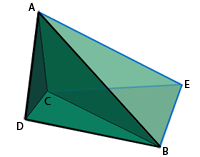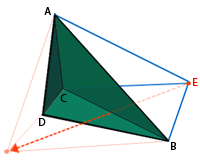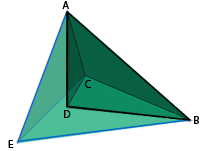Incorrect editing of a mesh can result in adjacent tetrahedron (tetra) overlapping. This is called an inverted tetrahedron.
Inverted tetra are detected with the Mesh Repair Wizard:  ().
().
Description
A tetra is a four sided, three dimensional shape that is the building block for 3D mesh analysis.
A tetra can have up to four neighbouring tetras, each of them sharing a common face. In Figure 1 below, we can see two tetras, ABCD and ACBE, that share a common face, ABC. The forth node of each tetra, D or E, are not part of the shared face. They are called the opposite nodes to the shared face.

Normal tetra
The two opposite nodes, D and E, should not be on the same side of the shared face. If the mesh was edited manually or generated by another product, it might result in the example where node E has been moved into a new position (Figure 2). The two tetras ABCD and ACBE still share the common face ABC, but their opposite nodes, D and E, are now on the same side of the shared face. In this case we would say that tetra ACBE is inverted, and the mesh has a connectivity error.

Node moved by incorrect editing

Inverted tetra
Impact on the analysis
When a mesh contains inverted tetras, the total volume of the solid model and the analysis results will be incorrect as volume will be measured and included in some analysis calculations more than once. The 3D Solver may also stop if inverted tetras are found.
Recommended action
It is essential to check for, and repair inverted tetras.
Inverted tetra cannot be repaired automatically. To repair an inverted tetra, check the connected triangles and manually correct the error.